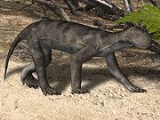
Lycaenops
Encyclopedia
Lycaenops is a genus
of carnivorous
therapsid (mammal
-like reptile). It measured about 1 meter (3 feet) long and lived during the late mid-Permian
to the early Late Permian in what is now South Africa
.
Like the modern-day wolves from which it takes its name, Lycaenops had a long and slender skull, with a set of dog-like fangs set into both its upper and lower jaws. These pointed canine teeth were ideal for the use of stabbing and/or tearing at the flesh of any large prey that it came upon. Lycaenops most likely hunted small vertebrates such as reptiles, small pelycosaurs, and dicynodont
s such as Robertia
and Cistecephalus
.
Lycaenops walked and ran with its long legs held close to its body. This is a feature found in mammals, but not in more primitive amniote
s and synapsid
s, such as the pelycosaur
s and early reptile
s, whose legs are positioned to the sides of their bodies. The ability to move like a mammal would have given Lycaenops an advantage over other land vertebrates, since it would have been able to out-run them.
Genus
In biology, a genus is a low-level taxonomic rank used in the biological classification of living and fossil organisms, which is an example of definition by genus and differentia...
of carnivorous
Carnivore
A carnivore meaning 'meat eater' is an organism that derives its energy and nutrient requirements from a diet consisting mainly or exclusively of animal tissue, whether through predation or scavenging...
therapsid (mammal
Mammal
Mammals are members of a class of air-breathing vertebrate animals characterised by the possession of endothermy, hair, three middle ear bones, and mammary glands functional in mothers with young...
-like reptile). It measured about 1 meter (3 feet) long and lived during the late mid-Permian
Permian
The PermianThe term "Permian" was introduced into geology in 1841 by Sir Sir R. I. Murchison, president of the Geological Society of London, who identified typical strata in extensive Russian explorations undertaken with Edouard de Verneuil; Murchison asserted in 1841 that he named his "Permian...
to the early Late Permian in what is now South Africa
South Africa
The Republic of South Africa is a country in southern Africa. Located at the southern tip of Africa, it is divided into nine provinces, with of coastline on the Atlantic and Indian oceans...
.
Like the modern-day wolves from which it takes its name, Lycaenops had a long and slender skull, with a set of dog-like fangs set into both its upper and lower jaws. These pointed canine teeth were ideal for the use of stabbing and/or tearing at the flesh of any large prey that it came upon. Lycaenops most likely hunted small vertebrates such as reptiles, small pelycosaurs, and dicynodont
Dicynodont
Dicynodontia is a taxon of anomodont therapsids or mammal-like reptiles. Dicynodonts were small to large herbivorous animals with two tusks, hence their name, which means 'two dog tooth'...
s such as Robertia
Robertia
Robertia was a small, primitive dicynodont, and among the earlier members of this group. The type species R. broomiana was named in 1981...
and Cistecephalus
Cistecephalus
Cistecephalus was a small, specialised, burrowing dicynodont, possibly with habits similar to a modern mole. The head was flattened and wedge-shaped, the body short, and the forelimbs very strong, with similarities in structure to the forelimb of modern burrowing mammals.It was one of the first...
.
Lycaenops walked and ran with its long legs held close to its body. This is a feature found in mammals, but not in more primitive amniote
Amniote
The amniotes are a group of tetrapods that have a terrestrially adapted egg. They include synapsids and sauropsids , as well as their fossil ancestors. Amniote embryos, whether laid as eggs or carried by the female, are protected and aided by several extensive membranes...
s and synapsid
Synapsid
Synapsids are a group of animals that includes mammals and everything more closely related to mammals than to other living amniotes. They are easily separated from other amniotes by having an opening low in the skull roof behind each eye, leaving a bony arch beneath each, accounting for their name...
s, such as the pelycosaur
Pelycosaur
The pelycosaurs are an informal grouping composed of basal or primitive Late Paleozoic synapsid amniotes. Some species were quite large and could grow up to 3 meters or more, although most species were much smaller...
s and early reptile
Reptile
Reptiles are members of a class of air-breathing, ectothermic vertebrates which are characterized by laying shelled eggs , and having skin covered in scales and/or scutes. They are tetrapods, either having four limbs or being descended from four-limbed ancestors...
s, whose legs are positioned to the sides of their bodies. The ability to move like a mammal would have given Lycaenops an advantage over other land vertebrates, since it would have been able to out-run them.
See also
- Evolution of mammalsEvolution of mammals__FORCETOC__The evolution of mammals within the synapsid lineage was a gradual process that took approximately 70 million years, beginning in the mid-Permian. By the mid-Triassic, there were many species that looked like mammals, and the first true mammals appeared in the early Jurassic...
- List of synapsids
- GorgonopsGorgonopsGorgonops is an extinct genus of therapsid which lived about 255-250 million years ago, during the latest part of the Permian Period. It was a typical representative of the suborder Gorgonopsia, the dominant predators of their day, which in the largest forms grew to over four metres long...

